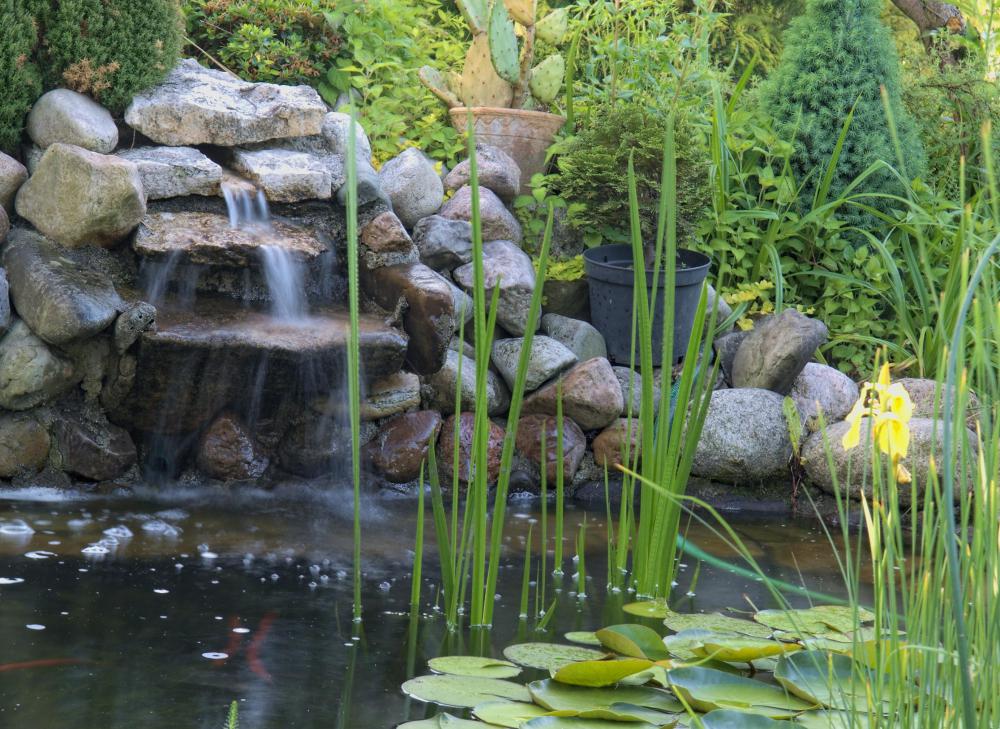At HomeQuestionsAnswered, we're committed to delivering accurate, trustworthy information. Our expert-authored content is rigorously fact-checked and sourced from credible authorities. Discover how we uphold the highest standards in providing you with reliable knowledge.
What Plants are Good for Wet Areas?
Wet and soggy soil is typically due to drainage issues and these types of areas can prove challenging when landscaping and gardening. Trying to correct the drainage issue may be necessary if it is affecting nearby structures, but sometimes there is nothing that can be done except to dress the area up with plants. Finding perennial plants and flowers that perform well in your home growing zone can be challenging enough without adding excessively moist soil to the mix, but the following are some plants that perform well in wet areas, given by their commercial rather than scientific names.
Irises do rather well in wet areas and in fact can actually be submerged in pots into ponds and water features. Look for the Blue Flag, Japanese, Siberian, and Yellow Flag irises. Irises grow taller than many flowers and bloom from early spring to summer in a variety of colors. Some hibiscus and lily plants also tolerate moist soil and flower nicely at various times of the year.

Many ferns seem to like wet areas, along with shade. Look for the Royal Fern or Lady Fern at your local nursery. Ferns have delicate “airy” looking leaves and vary in shades of green, with most being darker green. These water friendly plants add a touch of lushness to a garden. While most ferns tolerate wet soil, be sure you purchase a variety that will as a few prefer only damp to moderately drained soil.

For sunny but wet areas, any of the following plants and flowers should do nicely - Daylily, Bee Balm, Horsetail, and Marsh Marigold. For partial sun, Forget-me-nots, Jack-in-the-pulpits, and River Oats are suitable. For those difficult shady areas, try Jewel Weed or Sweet Woodruff in addition to ferns.
When planting in wet areas along streams or rivers, only plants that are native to the area should be used rather than introducing plants or flowers that are not indigenous. However, when planting a garden in a wet area away from running water it is suitable to experiment with different plants. The best thing you could do when choosing plants and flowers for wet areas and moist or soggy soil is to consult a nursery or horticulturist about the preferred growing conditions of specific plants and which ones will work well for the intended area.
AS FEATURED ON:
AS FEATURED ON:













Discussion Comments
@KoiwiGal - A wet area can be quite beautiful if it is planned out properly, but it can also very quickly look bedraggled or become an eyesore if it hasn't been well balanced and cared for.
I agree with the article writer that the best option is to go and ask around at local gardening shops, as every area will have different options for this kind of ecology.
You might also see if there are any local gardens where someone has worked with wet areas, as this could be a great source of information and inspiration.
@umbra21 - My problem with that is that it's very easy for water plants to become contaminated with harmful bacteria or chemicals. All it takes is for something to leech into the ground nearby and the water will carry it to the plants.
That's the main reason I won't pick watercress from our local stream either. I just don't think that it's a good idea to eat anything from water sources that aren't either completely managed, or located well away from urban and suburban areas.
It's not that difficult to grow water chestnuts in a small tank if you want them, or to just grow plants for qualities other than potential food.
If you're interested in growing vegetables and you've got a marshy area to use, then you've got a few options. There are some plants that you need a pond to grow, like lotus and water chestnut, or you could try growing something like watercress in wet areas.
Growing aquatic vegetables can be tough though, because you need to be able to access them without upsetting the plants and you won't be able to grow the variety that you would be able to in a drained vegetable garden. That's why most people interested in growing watercress tend to do it with aquaponics.
Post your comments